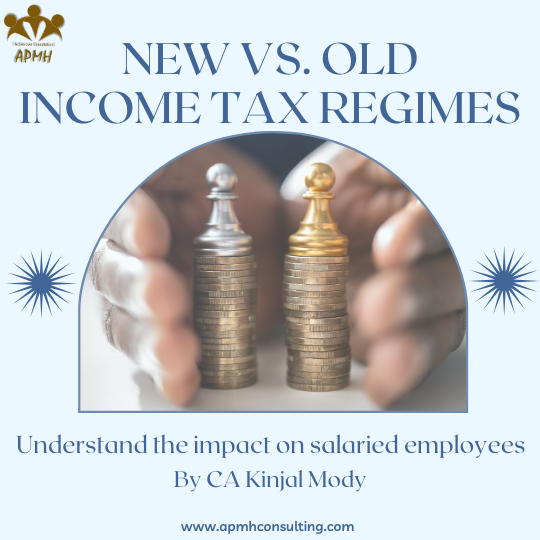12-Apr-2024 INCOME TAX – NEW REGIME vs OLD REGIME for SALARIED EMPLOYEES
income-tax standard-deduction tax-deduction-at-source taxes individual’s salary income financialplanningGet a grip on your taxes for FY 2024-25: Decide between the old and new tax systems, which affect how much you pay and what deductions you can claim. Make sure you understand your options to save money on taxes

Income tax rules for FY 2024-25: As the financial year 2024-25 has begun on April 1st, it is important to be aware of income tax rules. Even if changes are announced in the Union Budget or during the year, they usually take effect from the start of the new financial year. This year, there were no changes announced for FY 2024-25 in the interim budget, so the income tax rules from the previous year remain unchanged.
Here are the six income tax rules that will apply :
1. Choosing between old and new income tax regimes
For TDS (tax deducted at source) on salary, employees must select between the old and new tax regimes, states an ET report. The default option is the new tax regime. If you don't inform your employer about opting for the old tax regime, they will deduct tax based on the new regime from your salary. Make sure to do this promptly when requested by your employer.
2. Basic exemption limits
There's a difference in the basic exemption limit between the old and new tax regimes. If an individual's income doesn't exceed this limit in a financial year, they don't have to pay tax. Currently, under the new tax regime, income up to Rs 3 lakh is tax-exempt for all individuals, regardless of age. In the old tax regime, the exemption limit varies with age. For individuals below 60 years, Rs 2.5 lakh is exempt from tax, for seniors aged 60 to 80 years, it's Rs 3 lakh, and for super senior citizens aged 80 years and above, it's Rs 5 lakh.
Income tax slabs under new tax regime
| Income range (In Rs) | Income tax rate (%) |
| 0-3,00,000 | 0 |
| 3,00,001-6,00,000 | 5 |
| 6,00,001-9,00,000 | 10 |
| 9,00,001-12,00,000 | 15 |
| 12,00,001-15,00,000 | 20 |
| 15,00,001 and above | 30 |
Income tax slabs under old tax regime
| Income range (In Rs) | Income tax rate (%) |
| 0-2,50,000 | 0 |
| 2,50,001-5,00,000 | 5 |
| 5,00,001-10,00,000 | 20 |
| 10,00,001 and above | 30 |
3. Tax rebates
Income tax laws provide a tax rebate to resident individuals in both tax regimes. This rebate, available under Section 87A, does away with the need to pay tax if the net taxable income stays below a certain limit.
The new tax regime offers a higher rebate compared to the old one. Under the new regime, individuals can get a rebate of up to Rs 25,000, making incomes up to Rs 7 lakh tax-free. In contrast, the old tax regime offers a rebate of up to Rs 12,500, making incomes up to Rs 5 lakh tax-free
4. Deductions and exemptions: New vs old regime
Both tax regimes provide deductions and exemptions, but the old regime offers more. Examples of deductions and exemptions available under the old tax regime include standard deduction, Section 80C for investments and expenses up to Rs 1.5 lakh, Section 80D for health insurance premiums, and Section 80CCD (1B) for additional NPS investment up to Rs 50,000.
Additionally, deductions can be claimed for home loan interest up to Rs 2 lakh, education loan interest, and charitable donations. Moreover, individuals can also claim exemptions for house rent allowance (HRA) and leave travel allowance (LTA).
The new tax regime provides only two deductions for individuals. These include a standard deduction of Rs 50,000 from salary and pension income, and a deduction under Section 80CCD (2) for the employer's contribution to the NPS account. Family pensioners are also eligible for a standard deduction of Rs 15,000 under the new tax regime. It's worth noting that these deductions are also available under the old tax regime.
Claiming eligible deductions, depending on the chosen tax regime, allows individuals to decrease their net taxable income and tax liability.
5. Filing Income Tax Returns (ITR)
If you intend to choose the old tax regime when filing your income tax return this year, make sure to file your ITR before the July 31 deadline. This is crucial because the new tax regime is the default option, and income tax rules permit individuals to select the old tax regime only if their ITR is filed on time. If you file a belated ITR between August 1 and December 31, your tax liability will be calculated based solely on the new tax regime.
6. Surcharge rates
A high-income earner choosing the new tax regime will face a lower surcharge rate. For incomes exceeding Rs 5 crore, the rate has been reduced from 37% to 25% under the new tax regime. However, if the individual selects the old tax regime, a surcharge rate of 37% will apply.
Thank you Readers for your Time and Attention. If you have any questions or suggestions, please don't hesitate to reach out on info@apmh.in / kinjal@apmh.in. Your input is invaluable.
Related #Services
We belive in delivering quality and specific services as per the business requirements, which will help client getting a clear direction for growing its business.

